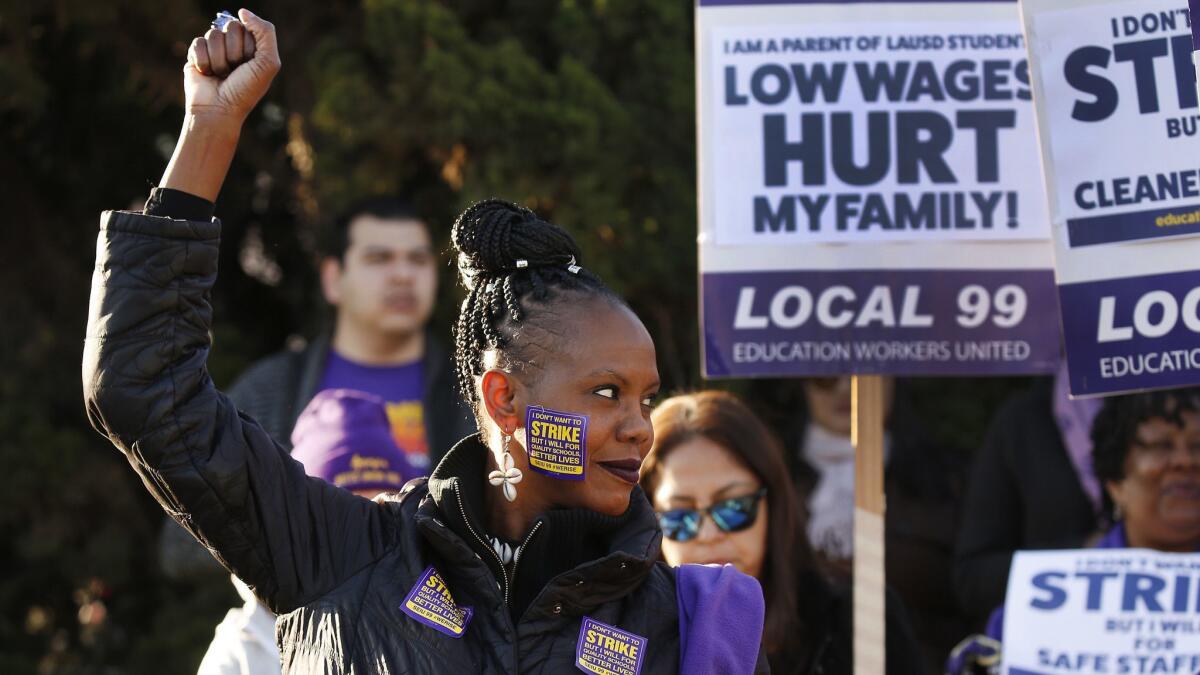After Supreme Court loss, school-employees unions gird for fight to keep their members

Leaders of school employee unions in California and nationwide know the future after Wednesday’s Supreme Court decision to strike down mandatory union fees: They’ll have to fight hard in faculty lounges, custodial offices and school bus depots to hold onto each member as anti-union forces try to pull them away.
The battle over school employees will be intense in California, where their unions, fueled by member dues, have long been a political force. Their strength has helped the state remain a bastion of liberalism and labor-friendly policy even as labor’s fortunes have suffered elsewhere.
Declining enrollment and the growth of mostly non-union charter schools has already made inroads on membership of local unions, including United Teachers Los Angeles. Teachers union membership in L.A. Unified has dropped from 42,000 to 31,000 since 2007, according to the school system.
Now anti-union forces funded by conservatives and corporate interests plan an aggressive campaign to reduce union clout, even to “deliver the mortal blow” as one fundraising appeal put it.
For teachers, union fees can run around $1,000. The fees that the court nixed in a 5-4 ruling in Janus vs. AFSCME typically make up about two-thirds of that total. States had been allowed to authorize public-sector unions to cover the cost of their work on contracts and grievances by collecting fair share fees from all those they represented, even people who didn’t want to be union members.
But the real target of this lawsuit is the core membership, said Lily Eskelsen García, president of the National Education Assn., the nation’s largest teachers union. Anti-labor groups “are going after our members” with “drop campaigns,” she said. “They are going to say …‘Why don’t you drop your membership and get it for free anyway?’ ”
Now, said Bruce Aster, an American government teacher at Carlsbad High School, “I think you’re going to see a number of teachers say, ‘I’m out of here. I’m going to collect my thousand bucks. And that’s going to put the onus on the union to win those folks back.”
Aster is a self-described social and fiscal conservative who has declined to join the local teachers union. He’s also a plaintiff in Yohn vs. CTA, another federal lawsuit against agency fees, which was on hold pending the outcome in Janus. Only a minority of teachers share his views on unions, but the numbers are enough to make a difference, he said.
Many union teachers and other school employees are optimistic that the unions can hold its ground.
“I really appreciate our union and will remain a member no matter what,” said Sharyn Obsatz, who teaches journalism at Santa Monica College and pays about $700 to belong to the Santa Monica College Faculty Association. She estimates that 90% of the faculty feel as she does.
In 2011, when unions lost agency fees in Wisconsin, membership and resources plummeted — but that’s unlikely in California, said Eric C. Heins, president of the California Teachers Assn. The union base here is stronger, the political landscape different.
In anticipation of Janus, the Democrat-controlled legislature has approved various measures that could help unions retain members.
Union influence has long shaped work rules in California. In collective bargaining, teachers can negotiate over such matters as class sizes, grievance procedures, layoff policies and teacher evaluations. In Wisconsin, teachers can bargain only over salary. In some other states, they can’t even do that.
The key going forward, said Heins, is to remain relevant to members by focusing on bargaining, protecting employee rights and helping teachers hone their craft.
If unions do feel new financial pressures and pull back from some political campaigns, other interests are likely to fill the vacuum, including pro-business groups, social conservatives and Democrats with less labor-friendly views. The latter group is likely to include supporters of charter schools.
In L.A., even with the financial strength of mandatory dues, the local teachers union was far outspent by charter supporters in recent school board elections. And last year charter-backed candidates won their first board majority.
Brannin Dorsey, a first-grade teacher and union leader in Fremont, said her local has learned that, if anything, it needs to ramp up political activities.
“Every decision made by the legislature and school board does affect us in the classroom,” Dorsey said. “We used to endorse in school board races only, but in 2016, we started endorsing in the city council and mayor races because we see the bigger picture, that everything is intertwined.”
Her union also has worked to communicate better internally, she said, because it “doesn’t work if people are coerced. …They really have to see a value in it. We have to find out what engages and excites teachers. For some, it’s social justice; for some, curriculum and developing professionally.”
Juan Flecha, the head of Associated Administrators of Los Angeles, has become more outspoken in recent months, consciously raising the profile of his union, which represents principals and other managers.
Earlier in his career, he said, “I may have been one of the members inclined not to continue paying dues. After all, I could easily repurpose the dollars for personal use.”
About one in five administrators represented by Flecha’s union have been paying only agency fees.
A similar percentage are full members of Local 99 of Services Employees International, which represents bus drivers, custodians, teacher aides and cafeteria workers in Los Angeles Unified and several other local school systems.
In this union, an internal recruiting campaign pushed membership from about 24,000 to about 28,000 over three years and also restructured to cut costs, said executive director Max Arias. The idea was to be stronger and more efficient, whatever happened with the Janus case.
Phylis Hoffman, a second-grade teacher at Harry Bridges Span School in Wilmington, hustled in recent months to get teachers to sign cards recommitting to the union — and all but one did so.
Such efforts may not be enough, said Meghann Seril, a teacher at Broadway Elementary.
“I’ve found that people have different levels of union participation and differing knowledge on Janus,” said Seril, the union chapter chair at her campus.
Anti-union organizations have developed sophisticated campaigns to urge members to leave. Groups active in California include the Freedom Foundation, which has an address in Fullerton, and the California Policy Center, based in Orange County.
That organization has compiled a database of union members through public records requests and plans to reach them through door knocking, canvassing, email, radio advertising, phone banking, billboards and digital advertising, said the group’s president Will Swaim.
Canvassers will be arguing that “unions haven’t created good value for their members.“
“There is a class struggle going on,” Swaim said, “but it’s the government-union leadership versus everyone else.”
More to Read
Sign up for Essential California
The most important California stories and recommendations in your inbox every morning.
You may occasionally receive promotional content from the Los Angeles Times.











